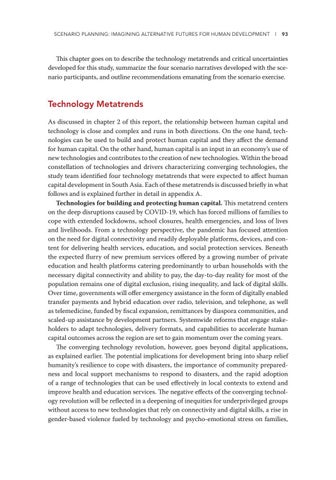SCENARIO PLANNING: IMAGINING ALTERNATIVE FUTURES FOR HUMAN DEVELOPMENT l 93
This chapter goes on to describe the technology metatrends and critical uncertainties developed for this study, summarize the four scenario narratives developed with the scenario participants, and outline recommendations emanating from the scenario exercise.
Technology Metatrends As discussed in chapter 2 of this report, the relationship between human capital and technology is close and complex and runs in both directions. On the one hand, technologies can be used to build and protect human capital and they affect the demand for human capital. On the other hand, human capital is an input in an economy’s use of new technologies and contributes to the creation of new technologies. Within the broad constellation of technologies and drivers characterizing converging technologies, the study team identified four technology metatrends that were expected to affect human capital development in South Asia. Each of these metatrends is discussed briefly in what follows and is explained further in detail in appendix A. Technologies for building and protecting human capital. This metatrend centers on the deep disruptions caused by COVID-19, which has forced millions of families to cope with extended lockdowns, school closures, health emergencies, and loss of lives and livelihoods. From a technology perspective, the pandemic has focused attention on the need for digital connectivity and readily deployable platforms, devices, and content for delivering health services, education, and social protection services. Beneath the expected flurry of new premium services offered by a growing number of private education and health platforms catering predominantly to urban households with the necessary digital connectivity and ability to pay, the day-to-day reality for most of the population remains one of digital exclusion, rising inequality, and lack of digital skills. Over time, governments will offer emergency assistance in the form of digitally enabled transfer payments and hybrid education over radio, television, and telephone, as well as telemedicine, funded by fiscal expansion, remittances by diaspora communities, and scaled-up assistance by development partners. Systemwide reforms that engage stakeholders to adapt technologies, delivery formats, and capabilities to accelerate human capital outcomes across the region are set to gain momentum over the coming years. The converging technology revolution, however, goes beyond digital applications, as explained earlier. The potential implications for development bring into sharp relief humanity’s resilience to cope with disasters, the importance of community preparedness and local support mechanisms to respond to disasters, and the rapid adoption of a range of technologies that can be used effectively in local contexts to extend and improve health and education services. The negative effects of the converging technology revolution will be reflected in a deepening of inequities for underprivileged groups without access to new technologies that rely on connectivity and digital skills, a rise in gender-based violence fueled by technology and psycho-emotional stress on families,
